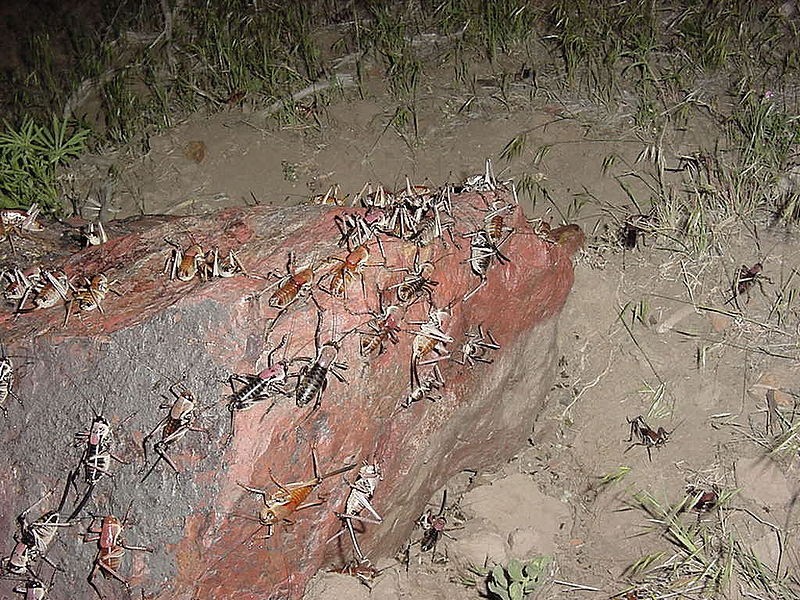Swarms of cannibalistic insects wreaking havoc on crops across the West. They resemble giant grasshoppers, and the harsh heat and arid conditions only serve to boost their numbers, leaving ranchers and farmers to deal with the ensuing mess.

Insect Outbreak
Farmers in the Western part of the United States are facing outbreaks of cannibalistic insects devouring crops from Nevada to Montana, on top of a worsening drought and increasing temperatures. Over the last few years, officials have spent millions of dollars attempting to manage the explosive swarms of Mormon crickets that have destroyed swaths of crops from Nevada to Montana.
Mormon Crickets
Mormon crickets were named for the enormous insects that devastated the crops of Mormon pioneers in the 1800s. According to the University of Nevada, Reno's College of Agriculture, Biotechnology, and Natural Resources, these insects are shield-backed, short-winged katydids that resemble chubby grasshoppers that cannot fly.
Outbreaks in the West have only worsened in recent years, and the climate issue may be partly to blame. According to The Associated Press, the bug, which can grow up to 2 inches in length, prefers hot weather and drought.
"Despite local and regional outliers, the Western U.S. drought has worsened since the beginning of 2020," AccuWeather Meteorologist Dave Houk stated. "Most of central Oregon is now experiencing severe drought."
Drought conditions promote Mormon cricket epidemics, and the U.S. According to the United States Department of Agriculture (USDA), these epidemics can result in billions of insects, causing significant economic and ecological damages to rangeland and crops.
According to the University of Nevada, these flightless insects typically move together, traversing at least a quarter of a mile daily. According to the USDA, consuming vegetation destroys innumerable crops and disrupts natural cycles such as erosion, water runoff, and nitrogen cycling.
Skye Krebs, an Oregon rancher, told the Associated Press that the breakouts were "really biblical."
Last year, Oregon was one of the hardest impacted states. According to the Associated Press, Mormon crickets and grasshoppers destroyed 10 million acres of rangeland in the Beaver State alone in 2021.
In 2017, Arlington, Oregon, saw one of the greatest Mormon cricket outbreaks since the 1940s. Krebs characterized the roadways in Arlington as "greasy" due to the squished entrails of the insects.
"On the roadways, once they're dead, the rest of them arrive," Krebs explained.
Tendency to Cannibalize

According to University of Nevada researchers, Mormon crickets are cannibalistic; if they are not filled with protein, they will feast on each other, dead or alive.
According to The Science Times, the Oregon Legislature established a Mormon cricket and grasshopper reduction program in response to the recent breakouts, funding $6.2 million to analyze the situation.
Private-State Partnerships
Private landowners, such as ranchers or farmers, can now request that the Oregon Department of Agriculture (ODA) inspect their property for Mormon crickets and grasshoppers under a new state effort. According to the USDA, the ODA will prescribe chemical treatment, such as a pesticide, if their survey uncovers more than three Mormon crickets or eight grasshoppers in a square yard. Still, they do not have the power to undertake suppression treatments without the landowner's written permission.
During the outbreak in Arlington in 2021, the Associated Press claimed that certain sites inspected in the town had more than 201 Mormon crickets per square foot.
After discovering the crawling insects on her 988-acre property in southwestern Oregon, Diana Fillmore contacted the ODA. Fillmore spent $45,000 on hay after the virus nearly destroyed the property last year.
Insect Suppression
This ODA program is only available to private landowners. The United States Constitution protects federally held public land. Department of Agriculture, which has its epidemic response program. Since the 1980s, the USDA's Animal and Plant Health Inspection Services (APHIS) has sprayed insecticides on millions of acres across the Western third of the country to suppress Mormon cricket and grasshopper populations.
APHIS National Policy Director William Wesela stated last year that the agency sprayed 807,000 acres of rangeland in seven Western states.
For the most recent updates about the environment and the animal kingdom, don't forget to follow Nature World News!
© 2025 NatureWorldNews.com All rights reserved. Do not reproduce without permission.





